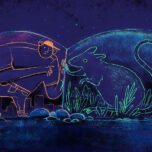May 1, 2020 — Rebecca Wong knows a thing or two about scouting exotic animals. She’ll root around in online forums, take tips from friends of friends, hang out at hotels and restaurants in a certain part of town. It takes time, and a bit of serendipity. “I go to a mixture of places,” she says. “You never know who can tell you where you can find them.”
Wong, who investigates China’s illegal wildlife trade networks at the City University of Hong Kong, has spoken to dozens of people who sell and buy wild animals through years of research. When she’s looking for species used for food, that fieldwork happens in restaurants and markets much like the one implicated in the spread of COVID-19 in Wuhan.
The memory of animals slaughtered or crammed in stalls is not one she likes to recall. “It’s not just the sight,” she says. “It’s also the smell.”
Places that trade in exotic fare aren’t the norm in China. “Many are disgusted by how animals are treated,” Wong says. Yet the domestic demand, combined with a booming international trade, is strong enough to drive an illegal industry worth up to US$26 billion per year that’s survived pandemics before.
The business of capturing an animal for sale has something in common with clearing forests for timber or to make way for farming, commercially or for local consumption. Both disturb nature in a way that can unleash pathogens from the wild, bringing them closer and into more frequent contact with humans, with sometimes far-reaching consequences.
The novel coronavirus that causes COVID-19 is a dramatic example. Others include the disease-causing entities that brought us SARS, Ebola, MERS and avian influenza. Together, they signal a growing threat from infectious disease outbreaks, including those caused by pathogens that jump the species barrier from non-human animals.

The transformation of rainforests into farmland to produce coffee and other crops creates opportunities for novel diseases to breach the border between wild animals and humans. Photo courtesy of Rod Waddington from Wikimedia, licensed under CC BY-SA 2.0
“Over 60% of the emerging infectious diseases we’ve seen over the last several decades have been from wildlife populations,” says Sam Myers, director of the Planetary Health Alliance, a global consortium focusing on how disrupting nature can affect human health. “And we know that the emergence of those diseases has been intensifying.”
Contact with forest animals centuries ago is even implicated in the origins of malaria, and the disease is still fueled by forest disturbance. But this isn’t about “someone else” doing the disrupting in a rainforest far away, or food preferences in unfamiliar cultures. The activities creating the right conditions for pathogens to spread are intimately connected to how people live and do business in both rich and poor countries.
Vicious Circle
Maria Anice Mureb Sallum, an epidemiologist at the University of São Paolo, believes that for malaria, control measures can never catch up as long as global trade keeps creating those conditions. “This is a vicious circle,” she says. “We have to rethink the use of commodities.”

Chocolate and infectious disease may seem unrelated, but clearing land to produce cocoa beans can increase the risk of illness-spreading interactions between wild animals and humans. Photos © iStockphoto.com/skynesher
Research by Sallum and colleagues recently pinned down the link between malaria risk and global trade by pulling together two familiar links in a chain: clearing forest to grow crops like coffee or cocoa beans, a known risk factor for the disease, and consumer demand that drives deforestation as well as carbon emissions. The researchers estimate that 20% of the risk of catching malaria in deforestation hot spots can be traced to exports that cater to rich countries’ appetite for popular products such as coffee beans and timber.
Grabbing a cup of coffee in rush hour might seem a world away from life in an African rainforest. But the study highlights how global systems connect them.
“Low-income countries pay for their cash crop export incomes with a burden from increased malaria risk,” the authors write. If a new disease finds a way to travel, other countries might pay a price too.
In the case of malaria, the risk is linked to deforestation among other factors including climate change. For the novel coronavirus, the evidence so far points to the wildlife trade. In the case of Ebola, the jump to humans is linked to hunting wild animals for food. In each case, there’s a connection between what we consume and the right conditions for a pathogen to escape the wild.
Supply Chains Under Scrutiny
Sallum and her colleagues conclude that malaria control should include policies targeting international supply chains that destroy forests. Take people making a living by logging in the Amazon, she says, making 250 reals (about US$50) for each tree they sell to Brazilian companies. “[That’s for] a huge tree, several hundred years old. And they [companies] sell the wood on the global market for a huge amount of money.” If policies brought more of the proceeds back to the loggers, she argues, they may need to harvest fewer trees — and so cause less of the ecosystem disruption that exacerbates malaria.

Loss of tree cover due to human activity and natural causes at the Landsat pixel scale, 2001–2017. Data from the Global Land Analysis & Discovery lab at the University of Maryland, Google, USGS and NASA. See ResourceWatch for interactive graphics and details.
Justin Adams is executive director of the Tropical Forest Alliance, which forges partnerships with companies trading in commodities implicated in deforestation to reduce their adverse impact. He cautions against drawing a direct link between habitat destruction and every disease, noting that details of how the new coronavirus emerged are still unclear. In the short term, when the humanitarian crisis caused by the pandemic is still unfolding, he says, it’s dangerous to target companies or demonize markets that are a vital source of food.
For one, Adams says, the commodities highlighted in the malaria research aren’t the ones responsible for the highest amounts of deforestation seen since 2000 — cattle, palm oil and soy.
“There’s a tendency to lump everything together and say, ‘well, of course, this all ends up as Unilever or Nestle supply chains — and that’s increasingly too simplistic,” he says. “There’s a far broader system that needs to be looked at, as opposed to simply saying, ‘It’s demand for products in the West that is driving it.’”
Adams says the pandemic will now “absolutely” increase the urgency of efforts that offer benefits to both the environment and human health. Western demand is already in the spotlight in the name of mitigating carbon emissions. Though progress is slow, companies have made commitments to change how they do business and become accountable for supply chains that destroy tropical forests.
The connection between that work on corporate accountability and human health has been much less visible. Adams says the pandemic will now “absolutely” increase the urgency of efforts that offer benefits to both the environment and human health. In signs of such a shift, Germany’s environment minister, Svenja Schulze, recently called for better communication of research into the link between environmental degradation and human health. And some investors foresee moves away from companies that trade in products linked to zoonotic disease and deforestation.
Preventing Future Pandemics
Myers says there’s a strong argument for changing our relationship with wildlife to prevent future outbreaks, and that means tackling the wild animal trade, bushmeat hunting and agricultural incursions into forested land. “From a public health standpoint, rethinking those practices makes a lot of sense,” he says.
Adams focuses on the complexities of how nature protection intersects with food supplies and health, and says links between them should be strengthened through existing mechanisms like the U.N. Convention on Biological Diversity, highlighted earlier this year at the World Economic Forum. “I hope it [the pandemic] creates more fertile ground for a deeper discussion about what and how we can transform these systems, because it’s the systems that are broken.”
Different solutions will come up depending on how one looks at the problem, according to Myers, and strategies will work best in different places. In places that are distant from emergence hot spots, the right response might be to stop pathogens spreading across borders. But where the risk of emergence is high, more focused surveillance is a good idea, he says. The non-profit EcoHealth Alliance, for example, runs a USAID-funded program to look for new zoonoses in several developing countries. It’s also working with Malaysia to put a price on disease prevention by incorporating the cost of disease into land use planning in Borneo, making the case for leaving some forests intact.
Other interventions could catch early signs of trouble. Reports that the novel coronavirus was spotted in water before or just after clinical cases emerged in the Netherlands suggest monitoring water supplies could play a part in early warning. And some scientists argue for better monitoring in places where zoonotic diseases are likely to appear first.
When it comes to the wildlife trade, Wong says policies that reduce consumer demand should be part of future public health efforts, too. “You have to have tougher enforcement, tougher laws. You also have to have behavioral change… and that has to be done by educational campaigns.”
Commercial pressure for the trade partly depends on the species. In the case of the pangolin, a suspected intermediate host for the novel coronavirus, the scales are prized for traditional medicine, a large industry in China. For items like ivory, there’s a global market. For salamanders, the appeal comes from cultural beliefs about their potency — “one guy told me he eats it because it makes him a better swimmer,” says Wong. Expense also makes it a status symbol, a prized item to show off on social media. And with a rising middle class, more people have the spending power to afford it. “It’s like having the latest sports car.”
There’s much yet to be learned about how COVID-19 emerged. But probing the connection with our daily lives and with systems that promote consumption could pave the way to a “new normal” where human interactions with nature carry less risk.
Related Posts
Ensia shares solutions-focused stories free of charge through our online magazine and partner media. That means audiences around the world have ready access to stories that can — and do — help them shape a better future. If you value our work, please show your support today.
Yes, I'll support Ensia!





Scientific thought on wave genetics, above all humility.